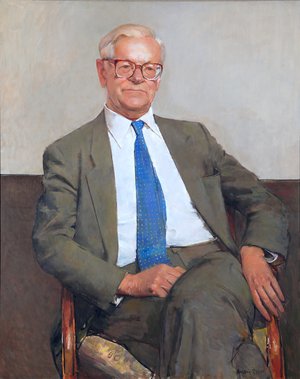Sir John Kendrew: a place in history
 The distinguished
scientist Sir John Kendrew CBE FRS (1917–97), President of St John’s (1981–87)
and winner in 1962, jointly with Max Perutz, of the Nobel Prize in Chemistry, is
the subject of a recent biography by Paul M. Wassarman, A Place in History (Oxford, 2020).
The distinguished
scientist Sir John Kendrew CBE FRS (1917–97), President of St John’s (1981–87)
and winner in 1962, jointly with Max Perutz, of the Nobel Prize in Chemistry, is
the subject of a recent biography by Paul M. Wassarman, A Place in History (Oxford, 2020).
Kendrew was a pioneer in structural biology and a catalyst in the development of molecular biology in the second half of the twentieth century. He was the first scientist to describe accurately the three-dimensional structure of a protein at atomic resolution, essential knowledge for progress in curing human diseases. Kendrew was a great advocate of British and European science, becoming an international organizer and leader, and he is remembered as one of the most gifted and influential pioneers among twentieth-century scientists. Kendrew’s memory lives on in St John’s through the quadrangle named after him and in his generous legacy of scholarships that, in keeping with his international and humanitarian concerns, are offered to a worldwide field of applicants from economically less developed countries.
 In his book, Wassarman
explores Kendrew’s personal and scientific life to uncover the background,
traits, and experiences of the man. He includes previously unpublished material,
demonstrating Kendrew’s vital role in the growth of molecular biology at three
world-famous scientific institutions: the Cavendish Laboratory, the Laboratory
of Molecular Biology, and the European Laboratory of Molecular Biology.
In his book, Wassarman
explores Kendrew’s personal and scientific life to uncover the background,
traits, and experiences of the man. He includes previously unpublished material,
demonstrating Kendrew’s vital role in the growth of molecular biology at three
world-famous scientific institutions: the Cavendish Laboratory, the Laboratory
of Molecular Biology, and the European Laboratory of Molecular Biology.
" John Kendrew was one of the most formidable of modern British scientists. He has, however, hitherto had no full-scale biography. Paul Wassarman has written an absorbing study of a man whose life is in many ways central to contemporary British life and culture. " Ross McKibbin FBA, St John's College